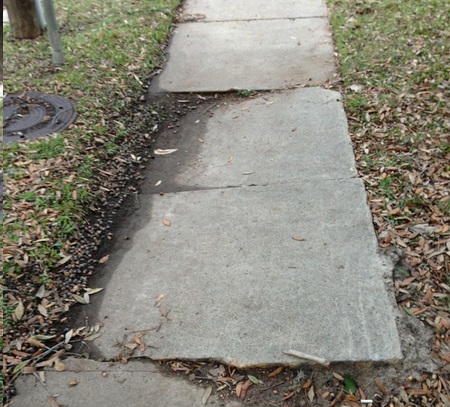
This evening we passed an ordinance that revamped our sidewalk repair program.
Agenda item 2j: Consider an ordinance amending multiple provisions of Chapter 31, Article IX, “Construction or Repair of Sidewalks,” of the Code of Ordinances of the City of Garland, Texas; providing a Savings Clause; providing a penalty under the provisions of Section 10.05 of the Code of Ordinances of the City of Garland, Texas; providing a Severability Clause; and setting an effective date. At the June 1, 2020 Work Session, Council considered a resolution authorizing the proposed amendments to Chapter 31, Article IX Construction or Repair of Sidewalks, Sections 31.120 thru 31.138.
Under the old policy, sidewalks that were eligible for cost sharing would get a 50/50 split with the city. Under the new policy, our cost sharing mechanisms change slightly to promote repair in older areas of the city, and focus on mobility along arterial streets. Before we look at the results of the policy change, I want to discuss some of the thinking that went into the changes.
We had a few problems with the old policy:
- It did not distinguish between high traffic and low traffic sidewalk usage. So you as a property owner would be held accountable for keeping a sidewalk repaired whether a person walked on it, or a thousand people used it.
- It did not have a focus on arterial mobility.
- It was funded in 2004 and still had funding in 2020 due to lack of use.
- It did not encourage economy of scale- meaning, it would help one person repair their sidewalk, but did nothing to encourage large segments of sidewalk repair at a significant savings.
- It was not in-line with other cost reductions in the city for senior citizens.
- It did not account for the skyrocketing cost of concrete.
Philosophically, a sidewalk is a shared resource for the public that property owners are charged with maintaining. Our cost sharing program is based on the concept that the public has a legitimate financial interest in keeping those sidewalks in working order, while property owners share in that cost to maintain their property. We extended this concept to maximize public benefit by making a distinction between normal sidewalk usage and repair -vs- heavy use sidewalks next to major thoroughfares. We also added additional cost relief for those in wheelchairs, and other appropriate mobility impairments. The new major points of the policy are outlined below:
- Project management is shifted from engineering to streets. This will tie some street projects into sidewalk repair.
- Defines arterial and collector streets (an example of an arterial street might be Buckingham Rd, collectors would be Marion, Sylvan, Kingsbridge, Sam Houston)
- The city will fully maintain sidewalks that border arterial streets. This is a significant change. Due to heavy public usage and the ability to add sidewalk repair to arterial street repair for pennies on the dollar, this is cheaper for the city to repair in full than a 50/50 split would be.
- Based on the previous point, for any full street rebuild project, we will rebuild sidewalks as well. It makes sense to do it all at once and come out ahead financially.
- Sidewalk work requires a 2 year warranty from the company that did the work
- Creates a graduated cost share setup:
- 15% additional discount if the property has a homestead exemption as defined by Dallas CAD
- 15% additional discount if the property is in a CDBG area as defined by HUD
- 10% additional discount if the property has a senior exemption or disability exemption as defined by Dallas CAD
- There is a maximum discount of 90% – For instance, if a homeowner is a disabled senior that also has a homestead exemption, and the cost of the project is $2000, the split would be:
75/25, City: $1500, Property Owner: $500
This does not mean that any and all sidewalk repairs qualify for this program. There is a specific set of criteria required before a cost share can be applied for. Because we just passed the ordinance this evening, we do not have an updated website/form for citizens to apply for the program yet, but that will be coming soon. I will update this post at the top once the new webpage is up.
The goal for us is to improve mobility in the areas that need it the most, and to achieve major cost savings during street replace/repair. I believe that this policy gets us further toward that goal. The policy was a part of the consent agenda this evening, which passed unanimously.
As always, if we see opportunities to tweak the program down the road, we’re open to more feedback. Please don’t hesitate to reach out.
-RJS